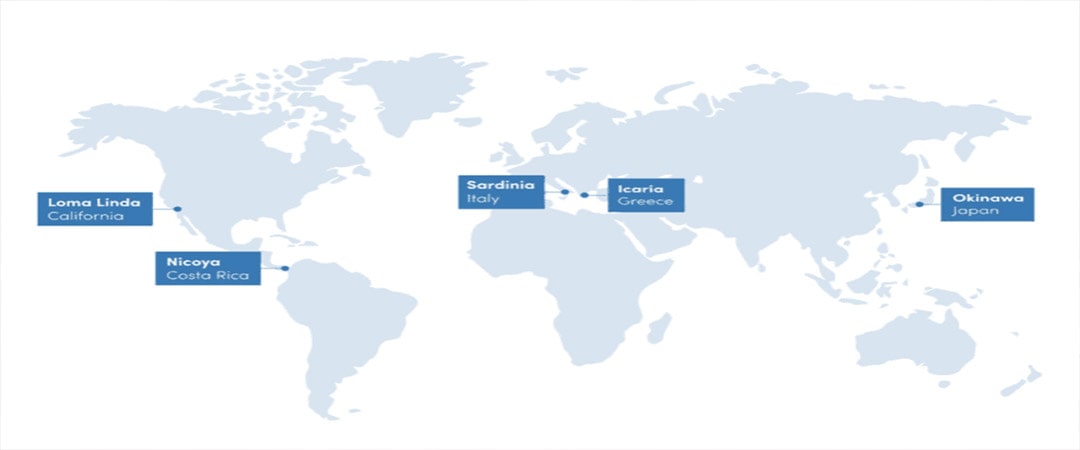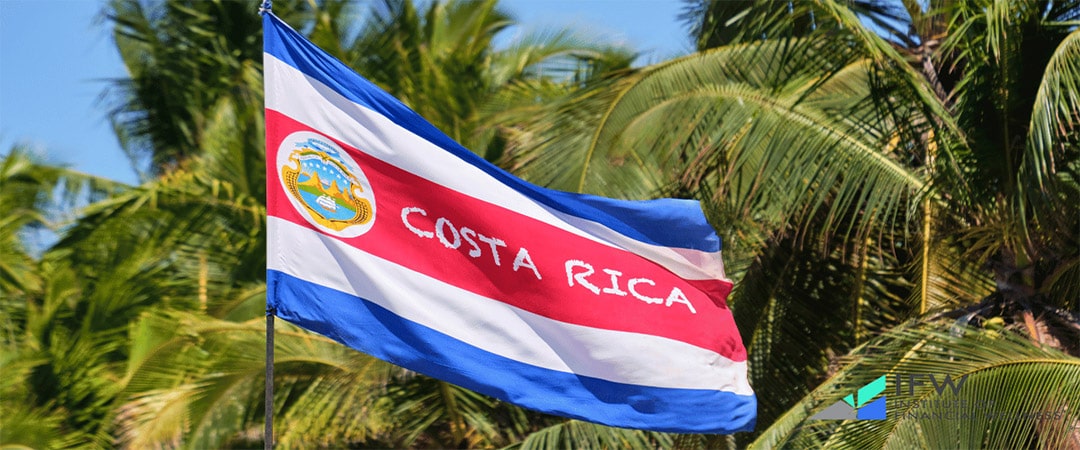No, Blue Zones are not resorts or handicap parking spots. Blue Zones are regions in the world where people seem to have sipped from the Fountain of Youth. They live longer, healthier lives, and while they’re not all out there running marathons at 100, they’ve got more centenarians per capita than the rest of us. Think of them as Mother Nature’s VIP lounges, where the secret password is a mix of diet, lifestyle, and community ties. Want in? Time to delve deeper into their age-defying ways!
The secret lies in the “Blue Zones,” regions where people enjoy exceptional longevity and well-being. Discover the fascinating world of Blue Zones and learn how to apply their principles to your own life for a healthier, happier future.
Key Takeaways
- Explore the World’s Blue Zones to uncover lifestyle factors that promote a long and healthy life.
- Key elements of a Blue Zone include plant-based diets, physical activity, social connections, restful sleep, and stress management.
- Incorporate these principles into your own life with help from experts in retirement, such as the Institute of Financial Wellness.
Exploring the World’s Blue Zones
The phrase “Blue Zone” was coined by Dan Buettner to describe the places where people are living longer and healthier lives, free from chronic illnesses like heart disease or dementia. These areas can be found in various parts of the world – ranging from Costa Rica all the way to Italy, Greece, Japan, and even Loma Linda, California.

On a map, one could spot them with blue circles around regions that contain some of the longest-lived women and men on our planet. What is it that makes these locations stand out among others? The answer lies within the distinctive lifestyle elements embedded in each Blue Zone location.
What is a Blue Zone Area
The lifestyle practices in the so-called Blue Zones are known to contribute significantly towards leading a longer and healthier life. These areas are characterized by a set of healthy behaviors that include regular physical activity, restful sleep, plant-based diets, moderate alcohol intake, and strong social ties. By embracing these practices, individuals can significantly reduce the risk of chronic diseases and dementia, leading to a longer life with good health.
In fact, research shows that environment and lifestyle choices contribute more significantly towards longevity than genetics. Therefore, it is essential to understand and adopt these practices to improve our overall health and well-being. For instance, regular physical activity, such as walking or gardening, can help reduce the risk of heart disease and other age-related diseases, while restful sleep can improve psychological well-being and reduce stress levels.
Similarly, a plant-based diet can provide essential nutrients while reducing the risk of chronic illnesses, and moderate alcohol intake can improve heart health.Having strong social ties and being part of tight-knit communities can also provide emotional support, leading to better psychological outcomes.By embracing healthy behaviors and making healthy choices, individuals can improve their chances of leading a longer and healthier life, just like the people living in the Blue Zones.
Blue Zone’s Life Expectancy
Blue Zone’s life expectancy isn’t just the number of candles on a really, really long birthday cake. It’s like Mother Nature handed these folks a VIP pass to the Century Club. While most of us are hoping our batteries last the typical 80-ish years, people in Blue Zones are out there, sipping herbal teas and dancing, with batteries that often run past the 100-year mark! So, if you’re eyeing a triple-digit birthday bash, it might be time to borrow a page from their playbook. And no, it’s not about finding the elixir of life; it’s about living it right!
The Blue Zones are known for having populations that live longer and healthier lives compared to the global average. For instance, people living on Ikaria, a small Greek island, have an average lifespan that exceeds an expected healthy age of 80 by an additional 8 years. Similarly, the residents of Nicoya, Costa Rica, often live past the age of 90 with good health. These findings suggest that adopting similar lifestyle choices as those seen in Blue Zones can significantly impact one’s lifespan and well-being.
Residents from Nicoya, Costa Rica, are known for often making it past 90 healthily. The results suggest how much influence adopting similar lifestyle choices as those seen in these “Blue Zone” locations can have on one’s lifespan and well-being.
It isn’t only major illnesses or chronic conditions that affect life expectancy, but also certain age-related diseases found all around the world that don’t exist within Blue Zone’s societies– embracing aspects of such lifestyles could prevent some types of ailments, reducing our chances of developing them leading us closer towards reaching healthier old ages with less suffering from prolonged issues along the way.
It is worth noting that it is not only major illnesses or chronic conditions that affect life expectancy but also certain age-related diseases that exist worldwide but not in Blue Zone societies. By adopting healthy behaviors and embracing aspects of these lifestyles, individuals can reduce their chances of developing such ailments, leading to healthier old ages with less suffering from prolonged issues along the way.
For instance, regular physical activity can help reduce the risk of heart disease and other age-related diseases, while a plant-based diet can provide essential nutrients and reduce the risk of chronic illnesses. Moderate alcohol intake and strong social ties can also contribute to better heart health and emotional support, respectively. These healthy behaviors have been observed in Blue Zones and can be adopted by individuals worldwide to improve their chances of living longer and healthier lives.
Therefore, it is essential to consider incorporating these healthy behaviors into our daily lives to increase our life expectancy and overall well-being. By taking inspiration from the Blue Zones and making healthy choices, we can all hope to live longer and healthier lives.
Key Factors Contributing to Longevity in Blue Zones

The secret sauce of Blue Zone longevity isn’t bottled up in some hidden elixir or ancient spellbook. Instead, imagine a recipe passed down through generations that’s a mix of fresh veggies, daily strolls, hearty laughter with friends, and a dash of purposeful living. It’s not just about the food on the plate, but the company you share it with. It’s not just the miles walked, but the purpose that drives each step. And spoiler alert: marathons and kale-only diets aren’t on the menu. It’s a life where slow and steady not only wins the race but also extends it!
According to research conducted by Dan Buettner, there are five known Blue Zones in the world [1]. These include Nicoya, Costa Rica; Loma Linda, California; Sardinia, Italy; Okinawa, Japan; and the Greek island of Ikaria.
The lifestyle of those living in Blue Zones is credited for their impressive life expectancy. These factors include:
- Plant-Predominant Diet: In terms of diet, the Blue Zone population favors whole grains, fruits, and vegetables and mostly consumes pork in moderation. Olive oil is a common ingredient in their cuisine. The Mediterranean diet is also prevalent in these regions, which emphasizes the consumption of plant-based foods and healthy fats.
- Move Naturally: Blue Zone residents aren’t typically gym rats. Instead, they incorporate natural movement into their daily lives, like walking, gardening, and manual chores.
- Purpose: They have a strong sense of purpose in life. Knowing your “why” or reason for getting up in the morning can contribute to longevity.
- Stress Reduction: While stress is a part of life everywhere, Blue Zone inhabitants have routines to shed stress. This could be through napping, happy hour, or prayer.
- 80% Rule: They eat mindfully and stop eating when they’re 80% full, helping to avoid overconsumption.[2]
- Moderate Alcohol Intake: Those who drink tend to do so in moderation, often sticking to 1-2 glasses a day, usually wine.
- Community: Moreover, the Blue Zones concept emphasizes the importance of having a support network, both financial and emotional, which has been found to have a significant impact on health and longevity. It is also essential to maintain healthy behaviors such as stress relief, weight management, and avoiding chronic illnesses.
- Family First: Strong family ties, with aging relatives often living in the same household or nearby, are a priority.
- Healthy Social Circles: The company you keep matters. Many Blue Zone inhabitants surround themselves with others who support and practice healthy behaviors.
- Engage in Life: Regardless of age, people in Blue Zones remain active contributors in their communities, often continuing to work, play, and engage in social activities.
Overall, the Blue Zones concept underscores the significance of lifestyle factors such as a healthy diet, physical activity, social connections, and emotional well-being in achieving a longer and healthier life. By adopting these habits and making healthy choices, people can improve their chances of living a long and healthy life.
In order to increase our chances of experiencing longer lives ourselves, we must understand and apply such core elements to our own lifestyles accordingly. Drinking moderately, for example, could contribute greatly towards achieving better health outcomes over time.
Where Do People Live The Longest?

The globe is home to five well-known Blue Zones, where people have been known for their long and healthy lives, each with its own special characteristics. They include Loma Linda in California, USA, Nicoya in Costa Rica, and Sardinia in Italy.
Ikaria is located in Greece and Okinawa from Japan – all of which are renowned for the highest concentrations of male centenarians around the world or having one of the best life expectancies on our planet. By exploring these areas, we can gain valuable information into discovering what factors contribute towards a healthier lifestyle that will enable us to experience human longevity.
The Power of Diet and Nutrition

No one should eat until they can’t eat anymore. Saying you’re stuffed after a meal is a sign that you are overeating. Sleeping after meals and feeling like you have a sack of concrete in your stomach is never a good thing.
Living in the Blue Zones has proven to have an impact on longevity due to dietary and nutrition habits. Residents of these regions eat predominantly plant-based diets full of fruits, vegetables, whole grains, legumes, nuts, and seeds – all while practicing mindful eating by adhering to principles such as Okinawa’s “80% Rule” that advises them when they should stop at 80%.
Moderate alcohol consumption is also observed among many from the blue zones (except for Seventh Day Adventists in Loma Linda), which research suggests decreases early mortality risk through improved cardiometabolic markers by 20%. By taking onboard this knowledge, we can use diet and nutrition techniques ourselves for a healthier life expectancy.
The Role of Physical Activity

Residents of the Blue Zone regions incorporate physical activity into their daily lives without putting in extra effort, leading to better health and well-being. Everyday activities such as gardening, walking around the house, or cooking are enough for people living here to reap its benefits.
Physical activity is an essential component of a healthy lifestyle and is a common factor among the world’s longest-lived people. In blue zones, people have a healthy lifestyle that includes regular physical activity, healthy dietary factors, and emotional and financial support. By following these lifestyle factors, they reduce their risk of major age-related diseases such as heart disease and almost no dementia.
They also have a sense of purpose in life, which contributes to their psychological well-being. In short, adopting the healthy habits of Blue Zone residents can lead to a longer and healthier life.
Research has suggested that individuals who exercise regularly have a decreased chance of early mortality. Thus, it is encouraged by experts to do at least 75 minutes per week worth of vigorous exercise or 150 moderate aerobic movement intervals every seven days in order to maintain healthy habits and prevent chronic illnesses from occurring. By adding regular physical activity to our lifestyle, we could increase overall well-being while reducing our risk factors significantly.
Psychological Well-Being and Social Connections

Social connections and psychological well-being are key factors for the long life span of inhabitants in Blue Zones. Having faith-based beliefs can bring about a reduction in depression, expanded social networks as well as an increased sense of purpose. Being part of a monogamous relationship adds up to three years to one’s life expectancy too. Family-oriented neighborhoods also give elderly citizens security and joy while protecting younger generations at the same time.
The Framingham study outlines how beneficial peer pressure is on lifestyle decisions such as promoting healthier eating habits, being happy instead of lonely, or abandoning smoking altogether.
The Importance of Sleep and Stress Management

Living in Blue Zones and having a long and healthy life is dependent on both sleep and stress management. Research has found that aiming for seven hours of nightly rest, as well as taking naps not exceeding thirty minutes, can significantly reduce the risk of mortality due to heart disease.
In order to be successful with this routine, it’s important to make time for relaxation activities such as observing the Sabbath or meditation, all of which bring about levels of relief from stressors. Combining these components together is fundamental when striving towards living an extended life full of healthiness.
Applying Blue Zone Lessons to Our Own Lives

The principles from Blue Zones can be utilized to improve our health and lifespan. These include prioritizing social connections, maintaining rituals in everyday life, switching to a plant-based diet, staying physically active, and recognizing the importance of having purpose in life.
The Blue Zone Checklists provide guidance on how one’s home environment can become more supportive for well-being. By following these healthy choices that are inherent within Blue Zone’s lifestyles, we lower the risk of chronic illnesses as well as lengthen our lives overall.
Blue Zones Projects: Creating Healthier Communities
Blue Zones Projects aim to promote a healthier lifestyle within local communities by making policy and social network alterations that help create better environments. This work seeks to encourage healthy practices in order for individuals living there can attain improved well-being.
In Los Angeles specifically, the implementation of Blue Zone principles has led to significant results like smoking rates declining 30%, BMI dropping 14%, and people engaging more regularly with good health behaviors. These projects ultimately foster an atmosphere that not only supports well-being but also helps reduce healthcare expenses overall.
True Vitality Test and Blue Zones Meal Planner

The True Vitality Test and the Blue Zones Meal Planner are tools that have been designed to aid people in cultivating habits from the “Blue Zone” regions, where individuals live longer. This test only takes 3 minutes of your time but provides you with personalized guidance on how to improve your health for a more extended lifespan. This meal planner helps users plan out their meals based on what those who dwell in these places consume, so they, too, may benefit from its longevity-enhancing effects.
By using both of these resources, we can make educated decisions regarding our wellness while potentially extending it at the same time!
Institute of Financial Wellness

The Institute of Financial Wellness is a non-profit organization that promotes financial well-being as essential to health, longevity, and a positive lifestyle. The purpose of their work lies in offering individuals the knowledge, resources, and emotional backing needed for making informed decisions about their well-being, including managing personal finances responsibly with long-term consequences in mind.
Financial education classes are provided through this institute, which aids people with budgeting and debt management planning while also providing them access to appropriate economic assistance opportunities when available. Thus leading to improved fiscal literacy and wiser money-related choices overall, resulting in greater financial security over time.
Full Summary
The insights gained from the Blue Zones can help us adopt a way of life that promotes long-term wellness and vitality. Particular lifestyle elements to keep in mind include engaging regularly in physical activity, consuming mainly plant-based foods, cultivating meaningful relationships with people around you, and finding healthy ways to manage stress. By embracing such principles taken directly from the Blue Zone ideology, we are able to cultivate healthier habits and build an existence full of gratification and longevity.
Frequently Asked Questions
What country do people live longest?
In 2023, Monaco has an impressive record when it comes to life expectancy, with its average age of 87 years being the highest in the world. Asian countries such as Hong Kong and Japan, as well as a few European nations like Switzerland and Italy, are among those ranking in the top ten for longevity.
Where do the most 100-year-olds live?
Sardinia, an Italian island 120 miles away from the coast of Italy’s mainland, is home to the highest concentration of centenarians in the world. It holds its own compared with Okinawa. Both places have 22 people older than 100 years old for every 100,000 citizens residing there.
Where do Americans live the longest?
Hawaii boasts the highest life expectancy in America, averaging 80.7 years from birth, three full years beyond the national mean. Washington and Minnesota follow behind with similarly notable longevity rates of their own.
What are the key lifestyle factors that contribute to longevity in Blue Zones?
Blue Zones are famous for their long-living residents, and this is largely attributed to certain lifestyle factors such as a diet based on plants combined with moderate alcohol consumption, regular exercise routines, enough sleep, and solid social relationships.




